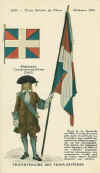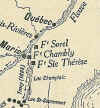|
The Carignan-Salières Regiment
The Salières Regiment had first been raised in 1630. The Carignan-Salières regiment derived its name from Colonel Thomas-François de Savoie, Prince of Carignan, who raised it in 1644 in Piedmont in northern Italy. During the following decade, the recruiting for the regiment was done in France, and the Piedmontese character of the corps gradually ebbed away. The Treaty of the Pyrenees, signed by France and Spain in 1659, resulted in a reduction in the number of regiments in the army. Instead of being disbanded, Carignan's unit was merged with another, and on May 31 of that year, the Prince of Carignan was politely advised that, in his absence, the command had been turned over "to a person of great capacity and experience ... Sieur de Salières ... colonel of an infantry regiment that is now incorporated into yours." A few years after this merger, the
Carignan-Salières Regiment had dwindled to eight companies, or 400 men,
which was its strength when selected to serve in Canada. Since the
king wished to send 1,000 men, 12 companies drawn from other regiments
were incorporated into it: four from the Lallier Regiment, four from
Chambellé, three from Poitou and one from Broglio. The arrival of
these 600 men probably gave rise to the eighteenth-century tale according
to which the Carignan-Salières Regiment had participated in 1664 in the
campaign in Hungary against the Turks, together with Austrian and German
troops. According to the tale, it performed "prodigies of
valour in the war against the Turks." Since the Carignan-Salières
Regiment was not actually numbered among the five infantry regiments sent
to Hungary in the French contingent, it seems likely that some of the
soldiers that were transferred to it came from these regiments and were
consequently veterans of this tough campaign. In April and May 1665, the 20 companies were reviewed in La Rochelle and declared complete, with "some even having more men than they needed." They then boarded the ships bound for Canada. The regimental staff included Colonel de Salières, Lieutenant-Colonel Du Port, Major La Freydière, Assistant Major Féraud, Adjutant La Combe-Pocatière, Chaplain d'Egriseilles and Surgeon Major Du Tartre. Each of the 20 companies had a captain, a lieutenant and an ensign as commissioned officers, and, as enlisted men, two sergeants, three corporals, five lance-corporals and forty soldiers, of whom at least one served as drummer. The first four companies arrived in Quebec beginning on June 19, 1665, followed by the colonel and eight other companies in August. The last eight companies came in September. In the meantime, the Marquis de Tracy had left Martinique with his soldiers. His fleet arrived in Quebec on June 30. Canada already had an acting governor, Monsieur de Courcelles, but the Marquis de Tracy was superior to him with power over all the colonies in North America. In view of the fact that there were only 3,200 people of French ancestry in Canada, of whom about 500 lived in or near the town of Quebec, it is easy to guess the emotions raised in that little colony by the announcement that such a large force was arriving. There was enough commotion just trying to find lodgings for all 1,200 soldiers and 80 officers! It was not long before the troops were deployed. By the end of August, eight companies had been sent to build strongholds all along the Richelieu. These became the forts of Sorel, Chambly, Saint-Jean, Sainte-Thérèse and Sainte-Anne. The four companies from the West Indies were attached to the Carignan-Salières Regiment but not incorporated into it, retaining their identification with their respective regiments. An Attack on the Iroquois
This plan was not lacking in audacity. The newly arrived soldiers were unfamiliar with the country, its distances, Amerindian tactics and the climate. All these factors made such an expedition extremely perilous, but the commanders did not wish to lose the initiative. In January 1666, therefore, some 300 soldiers under the command of Governor de Courcelles, accompanied by 200 Canadian volunteers, left Quebec on foot and set off doggedly through the snow, headed for Iroquois country. This was an astonishing undertaking, since at the time neither Europeans nor Amerindians usually fought in the winter. At Fort Sainte-Thérèse, a group of volunteers from Montreal swelled the ranks of the expedition, which continued on its way, though the men did not know exactly where they were. On February 17, the Dutch in the village of Schenectady were amazed to see large numbers of French soldiers pouring out of the woods, some shod in snowshoes and many pulling toboggans carrying their meager provisions. Since they were not at war, the Dutch were prepared to play host while the French recovered their strength. However, events overtook them. The French had barely arrived when a skirmish broke out with Mohawks, whom they had not seen until then. Then a British delegation arrived to call Courcelles to account for this incursion so close to the positions of the King of England! Courcelles was being faced with one surprise after another. He had found the Dutch when he thought he was among the Iroquois. New Holland was now the colony of New York, he learned, and Orange had been renamed Albany. Although the news had failed to reach Quebec before his departure, the English had in fact taken over the Dutch colony the year before. Even though the Mohawk villages were only a three-day march from Schenectady, the French were too exhausted and close to starvation to continue. They obtained some bread and peas from the Dutch, and, containing their anger, headed home. The losses in this campaign are difficult to evaluate on both sides. The Mohawks claimed to have killed a dozen French soldiers, captured two, and found five others dead of hunger and cold. They themselves had only three warriors killed and five wounded. They added, though, that they had been unable to inflict serious damage on the French expedition, which was very mobile. All this was consistent with French reports. The colonists thought at first that they had lost about 60 men, but this was later revised because "most of the soldiers whom [they] believed lost [were] returning day by day." This first expedition of the
Carignan-Salières Regiment turned out to be a total fiasco in relation to
its objective of destroying the Iroquois villages. However, it
had accomplished something almost unthinkable. A military
campaign had been conducted in the middle of a Canadian winter, and more
than 500 men had travelled over hundreds of kilometers of rough, wild
country, in one of the world's most hostile environments. In the spring and summer of 1666,
the French and Iroquois seesawed between armed skirmishes and attempts to
arrange peace talks. In July, Captain de Sorel succeeded in
approaching an Iroquois village with of a party of 200 soldiers and
volunteers and about 80 Amerindian allies. The Iroquois sent
out a peace envoy and liberated a few French captives, with whom Sorel
returned to Quebec. This expedition convinced his superiors
that Iroquois territory could easily be penetrated. Weary of
the incessant peace talks punctuated with bloody incidents, the Marquis de
Tracy decided upon a major expedition. In September 1666, at
the head of a small army of 700 soldiers and 400 Canadian volunteers
(including one battalion of Montrealers, the most experienced in
Amerindian warfare) as well as 100 Huron and Algonquin allies, Tracy,
Courcelles and Salières marched, drums beating, to the very heart of
Iroquois territory. The Iroquois hid in the forest and offered
no resistance as the invaders burned four of their villages as well as
their corn crops. These proud warriors, invincible in guerilla
warfare but impotent when attacked at home, discovered that their friends
and neighbours, the English and Dutch, were not prepared to provide
military support. The success of the Carignan-Salières
Regiment ensured an era of peace and prosperity in New France. The
colonists could finally settle down to their tasks without having to fear
constantly for their lives. The forts along the Richelieu not
only inhibited all movement from the south but also provided bases from
which to carry war into the heart of Iroquois country. In other
words, the initiative had passed into the hands of the French. The
routes to the West and its territory rich in fur lay open to their
explorers and traders. Finally, the nations annihilated by the
Iroquois were replaced by Ottawa's, Ojibwas and Algonquin's as trading
partners and military allies. The military campaigns had indeed
bestowed enormous benefits on New France. |
||||||
|
Credits: Much of this information was gathered from various sources. The primary source was the Canadian Military Heritage website. |
||||||

